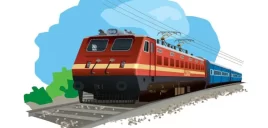What do the designations such as ‘WDM-2’ mean?
Locos, except for older steam ones, have
classification codes that identify them. This code is of the form ‘[gauge][power][load][series][subtype][suffix]’
In this the first item, ‘[gauge]’, is a single letter identifying the gauge the loco runs on:
W = Broad Gauge
Y = Meter Gauge
Z = Narrow Gauge (2′ 6″)
N = Narrow Gauge (2′)
The second item, ‘[power]’, is one or two letters identifying the power source:
D = Diesel
C = DC traction
A = AC traction
CA = Dual-power AC/DC traction
B = Battery electric(rare)
The third item, ‘[load]’, is a single letter identifying the kind of load the loco is normally used for:
M = Mixed Traffic
P = Passenger
G = Goods
S = Shunting
L = Light Duty (Light Passenger?) (no longer in use)
U = Multiple Unit (EMU / DEMU)
R = Railcar (see below)
The fourth item, ‘[series]’, is a digit identifying the model of the loco. Until recently, this series number was simply assigned chronologically as new models of locos were introduced.
Revised class notation for diesels, 2002: However, starting in 2002, for diesel passenger, goods, and mixed locos, i.e., WDP, WDG, and WDM sequences, (and only for them, apparently, not for electrics, nor for diesel shunters), the series digit identifies the horsepower range of the loco, with ‘3’ for locos with over 3000hp but less than 4000hp, ‘5’ for locos over 5000hp but less than 6000hp, etc. This new scheme will be applied to all passenger/goods/mixed-haul diesel locos starting in June 2002, except for the WDM-2 and WDP-1 classes of locos.
The fifth item, ‘[subtype]’, is an optional letter or number (or two of them) that indicates some smaller variation in the basic model or series, perhaps different motors, or a different manufacturer. With the new scheme for classifying diesel locos (see above), the fifth item is a letter that further refines the horsepower indication in 100hp increments: ‘A’ for 100hp, ‘B’ for 200hp, ‘C’ for 300hp, etc. So in this scheme, a WDM-3A refers to a 3100hp loco, while a WDM-3F would be a 3600hp loco.
The last item, ‘[suffix]’, is an optional indication that indicates something special about the loco, such as a different gearing ratio or brake system than usual.
So, a WCM-2 is a broad-gauge (W) DC electric (C) mixed traffic (M) engine, model 2. Likewise, a WDS/5 is a broad-gauge diesel shunting engine, model 5, and a ZDM-5 is a narrow-gauge diesel mixed-traffic model 5 loco. YAU-1 is the old series of MG EMUs run on the Madras-
Tambaram line.
The subtype indication of minor variations is not very systematic. Often successive variants of a model are given subtypes ‘A’, ‘B’, etc. in alphabetic order, e.g. ZDM-5A, WAM-4A, WAM-4B, etc., but not always. For many loco classes (WDM-2A, WDP-2A, notably), the ‘A’ also indicates dual braking systems (capable of hauling air-braked and vacuum-braked stock). But in some, such as the WDM-2CA, the ‘A’ indicates a loco with only air-brakes. A WAM-4R is a faster version (‘R’ for rapid?) of the WAM-4, and WAM-4P is a version of the WAM-4 designed specifically for passenger use (‘P’). But a WAM-4 6P is a version regeared and allowing all-parallel operation of the traction motors. A WDM-2P is a prototype version of a WDM-2 class.
Similiarly, a WAG-5HA is a WAG-5 with Hitachi motors (‘H’) built by CLW; a WAG-5HB is the same, but built by BHEL. A WAG-5P, interestingly, is a WAG-5 loco (a goods loco in its original design, as indicated by the ‘G’) which has been modified by re-gearing to haul passenger trains (the ‘P’ indicates ‘passenger’)! An ‘E’ suffix often indicates a variant that is purely air-braked (WAP-1E, WAM-4E, etc., but redundant with a WAP-4E.).
[5/02] As indicated above, a new system of classifying mainline diesels has been introduced. The new scheme got off the ground with rebuilt WDM-2C locos being reclassified as WDM-3A (as they have a power rating of 3100hp). It is likely that the new classifications will coexist with the old ones for some time.
With the optional suffix, things get even less predictable and less systematic. A WDM-2 5PD is a WDM-2 with a different gearing ratio (the ‘5P’, usually a ‘P’ in such a suffix indicates a gearing ratio suitable for passenger service). On the other hand a WAM-4 6P indicates all 6 traction motors permanently connected in parallel — in electric locos ‘S’ and ‘P’ often stand for ‘series’ and ‘parallel’ combinations of traction motors. Dual brake systems (‘D’); similarly with a WAM-4 6PD, another common designation. (It’s been reported that the ‘PD’ in these may actually refer to suitability for push-pull operation…??) A WAP-1 FMII is a variant of the WAP-1 using Flexicoil Mark II bogies.
Ad hoc combinations of many such suffixes are possible, as with ‘WAM-4 P HS DB 6P’ (HS = high speed, DB = dual-brake compatible, P = regeared for passenger operations, 6P = all 6 traction motors may be placed in parallel operation). The WAM-4 locos, in particular, are notorious for having countless minor variations as CLW and various workshops keep making minor experimental changes to them. Some sheds follow their own schemes too. Bhusawal shed, for instance, adds ‘DBC’ or ‘ABC’ to loco classes to indicate locos that have undergone conversion of the braking systems (‘dual brake converted’, and ‘air brake converted’).
The model numbers are assigned chronologically as new loco types are brought into use in IR, but there are some exceptions. Sometimes model numbers are assigned to some experimental locos which are never brought into regular use, e.g., WAG-8.
Some sheds have been known to use non-standard classifications; marking a WDM-2 loco as a ‘WDS-2’ to indicate it is used only as a shunter is perhaps one of the more egregiously confusing practices seen in some sheds. ‘WDM-2S’ is another notation seen at some sheds for WDM-2 locos relegated to shunting duties.
[4/09] Golden Rock Workshops has embarked on a program to convert old MG engines (YDM-4’s?) to broad-gauge; these are designated ‘WCDS-6’ where the ‘WC’ presumably stands for ‘Broad-gauge, Converted’.
Some classification codes break the system above: e.g., ‘RD’ is used as a code indicating the power and the load for diesel railcars, and not ‘DR’ as one might expect: YRD-1 is a series of MG railcars, NRD-1 similarly an NG series of railcars. Railcars used on the Tambaram line were classified simply ‘RU’. ‘RB’ is used for railbuses, e.g., the WRB railbuses built on Ashok Leyland bus frames operating between Bangarpet and Kolar.
EMUs followed this system for some time through the 1950s, but for quite some time now have not done so. There are numerous different models of EMUs with minor and major variations in use in the Mumbai system and in other systems, and they are no longer distinguished by ‘WCU-xxx’ class codes for them. See the DMU/EMU section for more information on types of these multiple units.
There are many ways in which the classification code appears in IR documents, painted on locos, etc.:
ये भी पढ़े – सिर्फ माउथफ्रेशनर से कहीं ज्यादा गुणकारी है सौंफ, जानें और बहुत से चमत्कारी गुण
WDM 2
WDM – 2
WDM / 2
WDM2
The Hindi version is usually a phonetic transcription of the way the classification code would be pronounced in English (‘double-you-dee-em’) with the series number in Hindi.
Steam: The last few models of steam locomotives used in India had this system of classification too, with one change, which was that the ‘power’ code was dropped. Hence: ‘WG’ = BG Goods steam loco, ‘WP’ = BG passenger steam loco, ‘YP’ = MG passenger steam loco, etc. However, there are literally hundreds of types of steam locomotives that have been used in India, and locos classified ‘WG’, ‘WP’, etc. are the exception rather than the rule. Steam locos were classified in a myriad of ways in India, with different systems used by different railways. Some standardization began with the IRS classifications (see below). Note: Sometimes these steam locos had additional notations, e.g., WGx referred to WG locos fitted with CBC couplers for working block freight rakes.
The serial number of a particular loco usually
follows the classification code on the sides and the front or rear (between the buffers) of the loco. See the item on numbering below.
Interestingly, DLW seems to have briefly used ‘V’ as the gauge indication for Cape gauge locomotives it was manufacturing for countries in Africa (Angola, Sudan, Mozambique, etc.). A 1350hp Cape Gauge locomotive intended for export to Angola and Sudan is sometimes seen designated ‘VDM-4’.
Source – IFRCA.org
INFORMATION CENTER – www.informationcenter.co.in
This entry was posted in 2 Railway Employee, Locomotive, Railway General Information, Railway Employee











